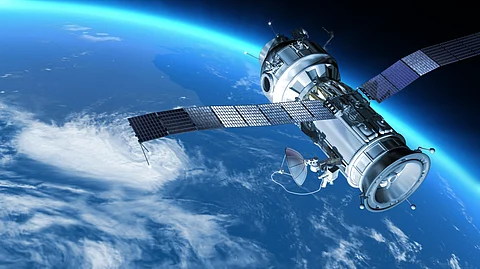

In 2024, space emerged as the new marketplace. Private players dominated the space economy, slated to be worth $1.8 trillion by 2035, as per the World Economic Forum (WEF) and management consulting firm McKinsey and Company.
Human presence in low-Earth orbit (LE0), 200-1,600 kilometres above the surface, has never been so prominent. Starlink, a subsidiary of the United States company SpaceX, launched over 2,000 satellites in 2024 compared to 120 in 2019, its first year, as per online tool Starlink Satellite Tracker. Starlink now has a mega-constellation of 6,000 satellites in LE0 that enables internet services in over 100 countries.
By the end of 2024, some 280 individuals visited the International Space Station in LE0. Scientific space missions and planetary explorations have also taken a leap.
In February, the world saw the sharpest-ever images of Jupiter’s volcanic moon Io, after US space agency NASA’s Juno made its closest flyby in two decades. That month, the US’ Intuitive Machines became the first private unit to soft-land on the moon.
China created history in June by becoming the first to transport lunar samples from the far side of the moon. The next month, Aditya L1—India’s first observatory to study the sun—completed its first halo orbit around the Sun-Earth Lagrange 1, a point 1.5 million km from the planet.
India also announced a mission to Venus; joining NASA and the European Space Agency (ESA) that announced similar missions in 2021. In 2025, the space sector and the related economy will be defined by these major developments:
The annual growth rate of the space economy will be around 9 per cent on average, higher than that of the global GDP (gross domestic product), as per WEF and McKinsey. This is expected to continue for a decade, likely making the sector a much-sought-after investment option.
Space tourism will consolidate further, demonstrating technological refinement and confidence in the sector, even though it is considered a billionaires’ indulgence. For example, as of November 2024, Blue Origin, a US firm, completed 28 commercial suborbital flights with New Shepard, a reusable launch vehicle developed for space tourism. By 2035, the space tourism market could be valued at $1.8-3.3 billion annually, according to Deloitte, a private technology firm.
Satellites will see enhanced operations for critical inputs in agriculture, information technology, insurance and construc-tion sectors. “Space technologies are delivering greater value to a more diverse set of stakeholders than ever before,” Sebastian Buckup, member of the executive committee, WEF, is quoted saying in an article on the organisation’s web-site.
In 2025, NASA will launch a mission to study galaxies and another to explore the moon. The space agency is also part-nering with the Indian Space Research Organisation to launch a mission to measure the Earth’s changing ecosys-tems. ESA plans to study the Earth-sun connection while China’s Tianwen-2 will collect samples from a near-Earth asteroid and study a comet.
This was first published in the 1-15 January, 2025 Print edition of Down To Earth